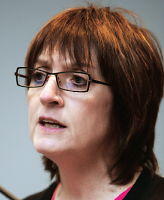Deep brain stimulation (DBS) may be an effective intervention for treatment-resistant depression, offering a way to reconceptualize depression and its treatment, said Helen Mayberg, M.D., during the Frontiers in Science Lecture at APA’s 2012 annual meeting in Philadelphia in May.
Mayberg described recent research and outlined future challenges to the use of DBS in treatment-resistant depression. “Neuromodulation of brain circuits implicated in depression using DBS as a new strategy has been facilitated by recent advances in stereotaxic neurosurgery, experience with stimulation of brain circuits in other neurological disorders, and the availability of structural/functional imaging to guide the use of DBS,” she said.
She is a professor of psychiatry and neurology and the Dorothy Fuqua Chair in Psychiatry Imaging and Therapeutics at Emory University.
Mayberg said the motivation for studying DBS derives from the incomplete success of current therapies for depression and the paucity of treatments for treatment-resistant depression. She noted that 40 percent of patients receiving psychotropic medication, cognitive-behavioral therapy, or another form of treatment achieve remission, but 10 percent become treatment resistant over time, and there are few options for patients who do not recover using ECT.
Moreover, she said, psychopharmacologic innovation has been stuck in a 50-year focus on monamines, with few new leads. Meanwhile there is no clear pathology to depression and no obvious biomarkers. And animal models of depression do not capture the phenomena of recurrence, relapse, and remission.
Most important, though, is the recognition that depression is a heterogeneous syndrome with different components that may be more or less prominent in any individual patient—negative mood, changes in cognition, delayed motor skills, and vegetative/circadian symptoms. Current treatments do not target specific areas of the brain relevant to specific components of the syndrome. “We know that one-size treatment does not fit all our patients,” she said.
Lessons Learned From Parkinson’s
But Mayberg said experience using DBS in patients with Parkinson’s disease has underscored the importance of targeting specific brain circuits relevant to specific symptoms of a disorder, an insight that can now be translated to treatment of depression with the assistance of positron emission tomography and functional magnetic resonance imaging. Specifically, she described the convergence of evidence indicating the role of the subcallosal cingulate (SCC) in driving negative mood in treatment-resistant depression and described research using DBS to target that area.
She outlined a working hypothesis for the neurobiology of treatment-resistant depression in which overactivation of area 25 of the SCC is triggered by a negative stimulus, followed crucially by a failure of the brain to correct itself. This failure to correct results in dysregulated connectivity with brain regions responsible for other components of depression, leading to chronic and sustained negative feelings, a state of “suspended animation.”
It is a state described subjectively by patients as the felt presence of emotional pain. One patient called it “a gnawing agony, a painful self-loathing that consumes all your energy and attention.”
In the first pilot study testing proof of principle, published in Neuron in March 2005, six patients with treatment-resistant depression received DBS targeting area 25 of the subcallosal cingulate.
Some responses of patients during the acute phase of implantation were striking. Mayberg quoted one patient as saying, “It is as though I have just suddenly shifted from a state of all-consuming internal focus to realizing that there are a number of things around to do.”
Another remarked, “When you’re depressed, the focus is inward. So if someone tells you, ‘Well you aren’t the only one who feels like that,’ you don’t care. With the stimulator, I don’t feel that inward look; it has lifted so I am not so focused on myself.”
Replications Are Encouraging
Replication studies have also been promising. In a report in the February Archives of General Psychiatry, Mayberg and colleagues assessed the efficacy and safety of subcallosal cingulate DBS in patients with treatment-resistant depression with either major depressive disorder (MDD) or bipolar II disorder. Ten patients with MDD and seven with bipolar were enrolled from a total of 323 patients screened.
Electrodes were implanted bilaterally in the subcallosal cingulate white matter. Patients received single-blind sham stimulation for four weeks followed by active stimulation for 24 weeks. Patients were evaluated for up to two years after start of active stimulation.
A significant decrease in depression and increase in function were associated with chronic stimulation. Remission and response (respectively) were seen in three patients and seven patients after 24 weeks; five patients and five patients after a year; and seven patients and 11 patients after two years of active stimulation. No patient achieving remission experienced a spontaneous relapse, Mayberg noted. Efficacy was similar for patients with MDD and those with bipolar disorder. The study was titled “Subcallosal Cingulate Deep Brain Stimulation for Treatment-Resistant Unipolar and Bipolar Depression.”
Future Steps
Despite promising early results, not all patients respond, and Mayberg said future steps include understanding the basis of differential response by refining electrode placement, optimizing effects by tuning the dose of stimulation and use of adjunct rehabilitation therapies, and determining predictors of response.
She likened the brain’s failure to correct following overactivation of the SCC to a defective gear shift in a car; DBS fixes the gear shift, but patients—some of whom may have been in a state of suspended animation for months—must still learn to drive the car again. “Without that gear shift, you aren’t going anywhere,” Mayberg said. “We need to reframe for our patients what it means to get better. Now that the car can move, where do they want to go? For clinicians this means working with patients to retrain to navigate the ups and downs of everyday life.”


